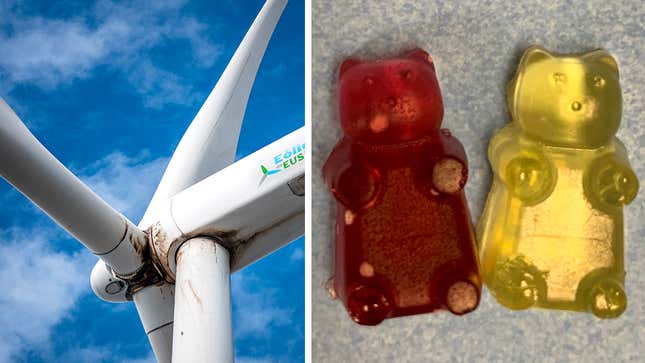
Despite being an excellent source of renewable energy, wind turbines, like most manufactured products, eventually need to be disposed of, for one reason or another. That poses an obviously large problem given their size, but researchers at Michigan State University are working on a novel solution: a newly developed material for making turbines that can be later recycled into everything from car parts to gummy bears.
The same arguments for upgrading your smartphone every year, such as improving its performance or replacing a device with a lot of wear and tear, apply to wind turbines too. Swapping in larger and lighter blades can improve the efficiency and power output of a wind turbine, but disposing of a mobile device that slips into your pocket is a lot easier than disposing of a fiberglass blade measuring over 250 feet in length—or three of them, to be exact. Current wind turbine blades can be recycled into other products, such as building materials, but the practice isn’t widespread yet, and these gigantic components instead often just end up in landfills.
A team of researchers from Michigan State University, led by John Dorgan, Ph.D., is trying to change that, and recently presented a novel solution to finding new life for wind turbine blades. During the fall meeting of the American Chemical Society (ACS), the group detailed how it had developed a new thermoplastic resin made of glass fibers combined with synthetic and plant-derived polymers. It’s strong enough to be used in making wind turbine blades, which when no longer needed, could be chopped up and dissolved to be recast into other products. Such products include car parts, but can also be much more unexpected.
When mixed with minerals, the dissolved turbine blades could be used to produce cultured stone products such as artificial granite countertops, or the recovered material could be crushed and mixed with other resins and used in injection molding machines to create toys or other plastic goods without a drop in the quality of the product.
Processing the recovered material in other ways yields even more intriguing recycling possibilities. An alkaline solution can be used to digest the thermoplastic resin to release poly(methyl methacrylate): a clear plastic material often used as a durable alternative to glass. With higher temperatures, we can go one step further to convert the poly(methyl methacrylate) into poly(methacrylic acid): a super-absorbent material used in diapers. A by-product of these recycling processes is potassium lactate, which after being purified to the point of being food-grade, was used by the team to create gummy bear candies—which they ate.
The next step is using the new thermoplastic resin to actually make wind turbine blades to test how they hold up in real world conditions such as rain, snow, and anything else Mother Nature can throw at them. Successful testing could see a greater demand for the new bioplastic, which the team hopes will lead to interested companies manufacturing it en masse as a viable and affordable alternative to traditional fiberglass materials. If it’s impossible to source, and too expensive, it doesn’t matter how easy it is to recycle: no one’s going to want to use it.